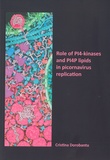Role of PI4-kinases and PI4P lipids in picornavirus replication

Dorobantu, Cristina
- Promoter:
- Prof.dr. F.J.M. (Frank) van Kuppeveld
- Co-promoter:
- Dr. H.M. (Hilde) van Tongeren
- Research group:
- Kuppeveld
- Date:
- September 27, 2016
- Time:
- 10:30 h
Summary
Picornaviruses, like other +RNA viruses, reorganize intracellular membranes into so-called viral replication organelles (ROs), where virus genome replication occurs. These virus-induced ROs are novel structures with unique architecture, protein and lipid composition. Requirements for picornavirus RO formation and functioning are currently poorly characterized. In this thesis, we investigated in detail how distinct picornaviruses drive the biogenesis of their ROs.
On the one hand, we studied how picornaviruses from the genus Enterovirus, namely coxsackievirus and human rhinovirus, recruit the Golgi-localized enzyme PI4KB (phosphatidylinositol 4-kinase isoform IIIbeta) to their ROs. PI4KB is an essential enterovirus host factor proposed to be recruited to enterovirus ROs by the viral protein 3A, via the Golgi-localized factors GBF1/Arf1 or ACBD3. Both GBF1/Arf1 and ACBD3 were previously shown to be important for the recruitment of the kinase to Golgi membranes in non-infected cells. By performing a systematic analysis of PI4KB recruitment to membranes in both in vitro systems and in intact cells, we demonstrate that neither GBF1/Arf1 nor ACBD3 are in fact required for PI4KB recruitment to ROs. Although we detected a direct interaction between 3A and ACBD3, ACBD3 proved to be dispensable for enterovirus replication. Thus, the mechanism of PI4KB recruitment to ROs by 3A, which may occur via an unknown cellular co-factor or via a transient direct interaction, remains obscure.
On the other hand, we also describe how picornaviruses from the genus Cardioviruses develop their ROs, using encephalomyocarditis virus (EMCV) as a prototype cardiovirus. We show that like enteroviruses, cardioviruses also build ROs enriched in PI4P (phosphatidylinositol 4-phosphate), but by hijacking the ER-localized PI4KA (phosphatidylinositol 4-kinase isoform IIIalpha) instead of PI4KB. We demonstrate that PI4KA activity is required for EMCV genome replication and that PI4KA is recruited to EMCV ROs by interacting with the viral protein 3A. PI4P is important for the recruitment of oxysterol-binding protein (OSBP) to the ROs. OSBP functions at ER-RO membrane contact sites (MCSs) to shuttle cholesterol to the ROs in exchange for PI4P. Blocking the PI4P/cholesterol shuttling function of OSBP proved detrimental to both EMCV genome replication and the overall integrity of the ROs. These findings revealed a striking convergence of EMCV and hepatitis C virus (HCV) with respect to host factor usage, since HCV was also shown to hijack the PI4KA-OSBP pathway. Furthermore, we reveal that EMCV can escape PI4KA inhibition by acquiring single point mutations in the viral protein 3A. These EMCV mutants could bypass the need for PI4KA/PI4P and cholesterol, but not OSBP, arguing that the mutants may still require a yet unknown function of OSBP, possibly not related to PI4P/cholesterol shuttling, which remains to be determined. Finally, using the EMCV mutants, we discover that the EGFR inhibitor Tyrphostin AG1478 is also a PI4KA inhibitor with antiviral activities against EMCV and HCV.
While our studies provide important mechanistic insights into the development of picornavirus ROs, the role of PI4P and cholesterol in virus replication awaits further investigation. A deeper understanding of the virus-host interactions underlying RO biogenesis and functionality may lead to the development of future therapies to combat picornavirus infections, for which currently no treatment is available.